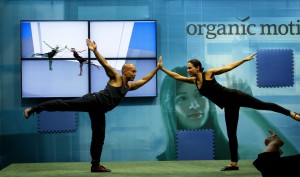Computer vision technology enables markerless motion capture for more spontaneous performances. The technology has promise for new interfaces in the near future.
Siggraph has major real estate devoted to motion capture technologies. Every year, the floor is littered with shapely male and female human puppets dancing for no one. Organic Motion hopes to stand out this year with their new technology. The company’s OpenStage line of motion capture systems is markerless. It relies on the company’s computer vision software and high speed color cameras. We met with Andrew Tschesnok, Organic Motion’s Chief Executive. He said that a complete re-write of the company’s product has enabled them to overcome the limitations of the technology. For instance, says Tschesnok, it had to have a background, it was limited to the number of actors it could capture, and it required 14 cameras. The new system is much more flexible. It does not require a backdrop, systems can be set up with 8 to 24 cameras, and it can capture multiple actors. And, the area used for capture is flexible, it can be an area as small as a phone booth, or as large as 30×30 ft. The really fundamental difference says Tschesnok, is that the system can capture anything. For example, not only can actors be captured but so can the props they’re using.

Organic Motion works with a workstation and Autodesk’s MotionBuilder. A capture session is set up by defining the subjects to be captured. You identify control points, etc., and the system can then follow the desired subjects. Clearly excited about the coming product, Tschesnok talks about the potential for capturing movements from anything. He says you can capture a snake on the ground or a horse. “We can track anything,” he says. Comparing the technology to that of Microsoft’s Kinect, Tschesnok says, “we’re like the pro version of Kinect.”
Organic Motion describes three market segments: animation, education, and public interactive exhibits. Early customers signing on for the new systems include Game On Audio in LA, the School of Visual Arts in New York, University of California at Santa Cruz, and ZeroC7 in Japan.
Motion capture in the traditional sense is only part of Organic Motion’s plans. The company and their customers are looking at new ways of interacting with the computer. One of Organic Motion’s largest customers at the moment is the military. “They’re building holodecks,” says Tschesnok. The army is interested in building better simulators that people can spontaneously interact with and Organic Motion’s technology is getting them there.
What do we think?
The computer vision technology that the Organic Motion team lead by CEO Andrew Tschesnok is more than a nifty way to capture performance. The company is investigating new forms interface development and I/O. This technology can change not only the way entertainment is made, but how we consume it. It can not only change the way we communicate with our computer but how we interact with the world. This technology can find its way into everything including home automation, security systems, and more. — K.M.





